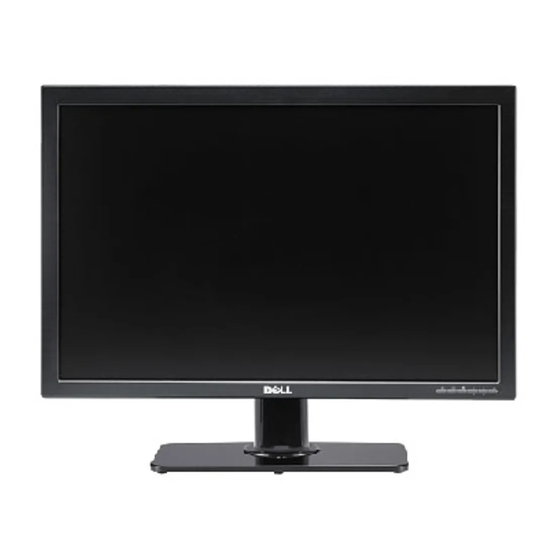Dell 3008WFP - UltraSharp - 30" LCD Monitor Manuale d'uso - Pagina 34
Sfoglia online o scarica il pdf Manuale d'uso per Desktop Dell 3008WFP - UltraSharp - 30" LCD Monitor. Dell 3008WFP - UltraSharp - 30" LCD Monitor 38. Flat panel monitor
Anche per Dell 3008WFP - UltraSharp - 30" LCD Monitor: Manuale di configurazione (2 pagine), Specifiche tecniche (2 pagine), Opuscolo (2 pagine)

Back to Contents Page
Solving Problems
Dell™ 3008WFP Flat Panel Monitor User's Guide
Monitor Specific Troubleshooting
Common Problems
Video Problems
Product Specific Problems
Universal Serial Bus Specific Problems
Troubleshooting the Dell™ Soundbar
Troubleshooting the Card Reader
CAUTION:
Before you begin any of the procedures in this section, follow the
Monitor Specific Troubleshooting
Self-Test Feature Check
Your monitor provides a self-test feature that allows you to check whether your monitor is functioning properly. If your monitor and computer are properly
connected but the monitor screen remains dark, run the monitor self-test by performing the following steps:
1. Turn off both your computer and the monitor.
2. Unplug the video cable from the back of the computer. To ensure proper Self-Test operation, remove both Digital (white connector) and the Analog (blue
connector) cables from the back of computer.
3. Turn on the monitor.
The floating dialog box should appear on-screen (against a black background) if the monitor cannot sense a video signal and is working correctly.
While in self-test mode, the power LED remains blue. Also, depending upon the selected input, one of the dialogs shown below will continuously scroll
through the screen.
4. This box also appears during normal system operation if the video cable becomes disconnected or damaged.
5. Turn off your monitor and reconnect the video cable; then turn on both your computer and the monitor.
If your monitor screen remains blank after you use the previous procedure, check your video controller and computer, because your monitor is functioning
properly.
NOTE:
Self test feature check is not available for S-Video, Composite, and Component video modes.
Common Problems
The following table contains general information about common monitor problems you might encounter and the possible solutions.
Common Symptoms
What You
Experience
No Video/ Power LED off No picture
No Video/ Power LED on No picture or no
brightness
Poor Focus
Picture is fuzzy,
blurry, or ghosting
Shaky/Jittery Video
Wavy picture or
fine movement
Missing Pixels
LCD screen has
Safety
or
Ensure that the video cable connecting the monitor and the computer is properly connected and secure.
l
Verify that the power outlet is functioning properly using any other electrical equipment.
l
Ensure that the power button depressed fully.
l
Increase brightness & contrast controls via OSD.
l
Perform monitor self-test feature check.
l
Check for bent or broken pins in the video cable connector.
l
Ensure that the correct input source is selected via the Input Source Select button.
l
Run the built-in diagnostics.
l
Perform Auto Adjust via OSD.
l
Adjust the Phase and Pixel Clock controls via OSD.
l
Eliminate video extension cables.
l
Reset the monitor to Factory Settings.
l
Change the video resolution to the correct aspect ration (16:10).
l
Perform Auto Adjust via OSD.
l
Adjust the Phase and Pixel Clock controls via OSD.
l
Reset the monitor to Factory Settings.
l
Check environmental factors.
l
Relocate the monitor and test in another room.
l
Cycle power on-off.
l
Instructions.
Possible Solutions
